Chandrayaan-2
Chandrayaan-2/Čandraján-2
je druhá mesačná prieskumná misia Indie po Čandraján-1.[1] Vyvinutá indickou organizáciou pre výskum vesmíru (ISRO). Misia použije nosič Geosynchronous Satellite Launch Vehicle Mark III (GSLV Mk III).[2] Obsahuje lunárny orbiter, lander a rover, všetko vyvinuté Indiou.[3]Štart 22. 7. 2019 v 09:13 UTC a pozemná sonda s vozítkom sa pokúsila o mäkké pristátie 6. 9. medzi dvoma kráterami Manzinus C a Simpelius N na južnej mesačnej šírke asi 70 °. Mala byť druhou misiou s pristátím rovera v blízkosti lunárneho južného pólu. [5] Vo výške 2,1 km nad povrchom sa spojenie s pristávacím modulom stratilo.
| Landing site[21] | Coordinates |
|---|---|
| SLS54 (prime site) | 70.90267°S 22.78110°E |
| ALS01 (alternate site) | 67.87406°S 18.46947°W |
https://quickmap.lroc.asu.edu/query?extent=20.9235019,-71.3984625,24.6518052,-70.3966748&proj=17&features=22.78134979,-70.90267212|22.78107852,-70.90268212,22.77443866,-70.86865001|22.78117352,-70.90271036,22.75525313,-70.73882566|22.78400000,-70.88100000|22.78127317,-70.90267484,22.78410059,-70.88102301,22.78402736,-70.88101264,22.78405726,-70.88098726&selected=4&layers=NrBsFYBoAZIRnpEoAsjZwLraQJlLjIgiLgBwDMGRWOw4cU1J9cAnOvJkhXHBZ1rYgA
https://quickmap.lroc.asu.edu/query?extent=21.307124,-71.2774112,24.1374189,-70.4757456&proj=17&features=22.78110000,-70.90267000|22.78107852,-70.90268212,22.77443866,-70.86865001|22.78117352,-70.90271036,22.75525313,-70.73882566|22.75525313,-70.73882566,22.56655607,-70.90546511,22.99092145,-70.89961701,22.75525313,-70.73882566&selected=0&layers=NrBsFYBoAZIRnpEoAsjZwLraQJlLjIgiLgBwDMGRWOw4cU1J9cAnOvJkhXHBZ1rYgA
https://quickmap.lroc.asu.edu/?extent=20.9110912,-72.6817971,27.1768896,-69.0377407&proj=16&features=22.78110000,-70.90267000|22.78107852,-70.90268212,22.78916739,-70.86780849|22.78117352,-70.90271036,22.81728338,-70.73719689|22.81702357,-70.73858261,22.56614244,-70.89752943,22.57584305,-70.89775474,22.99511465,-70.90749291,22.81702357,-70.73858261|32.85000000,-70.90267000|31.85000000,-70.90267000|30.80000000,-70.90267000|29.83000000,-70.90267000|28.82000000,-70.90267000|27.82000000,-70.90267000|26.82000000,-70.90267000|25.81900000,-70.90267000|24.81000000,-70.90267000|23.79000000,-70.90267000|32.64095000,-70.90267000|31.61576000,-70.90267000|29.62652000,-70.90267000|28.61989000,-70.90257000|27.62898000,-70.90267000|26.61776000,-70.90267000|23.56779000,-70.90267000|22.56691000,-70.90267000&layers=NrBsFYBoAZIRnpEoAsjZwLraQJlLjIgiLgBwDMGRWOw4cU1J9cAnOvJkhXHBZ1rYgA#
LRO period orbit over Moon 01:57 min
LRO flyby over planned landing site:
Last 17 sep 2019 17:37 or by horizons.com 19:35 UTC
17th Sep 2019 17:37plus 27,321661 days = 15th Oct 2019 01:20
17th Sep 2019 19:35 plus 27,321661 days = 15th Oct 2019 03:18
The Libration in longitude of the Moon was 17th 7:50 Sep 6.4 ° and 14th Oct 15:30 6.2 °
In latitude is irrelevant.
By Horizons.com: LRO overflies site 15th Oct 2019 01:26 UTC
STK: LRO overflies site 15th Oct 2019 02:07:14 UTC
The Libration in longitude of the Moon was 17th 7:50 Sep 6.4 ° and 14th Oct 15:30 6.2 °
In latitude is irrelevant.
By Horizons.com: LRO overflies site 15th Oct 2019 01:26 UTC
STK: LRO overflies site 15th Oct 2019 02:07:14 UTC
by Qiuckmap Lroc:
Planed Landing Site:
by wikipedia 70.90267°S 22.78110°E
by LROC and NASA 70.8°S latitude, 23.5°E longitude

http://www.unmannedspaceflight.com/index.php?act=attach&type=post&id=45088
Podľa ISRO táto misia použije a otestuje rôzne nové technológie a uskutoční nové experimenty. Kolesový rover sa mal pohybovať na povrchu Mesiaca a vykonávať chemické analýzy. Údaje mali byť odovzdávané na Zemi cez modul Čandraján-2 na orbite.
 |
| Launch configuration. At 3850 kg |
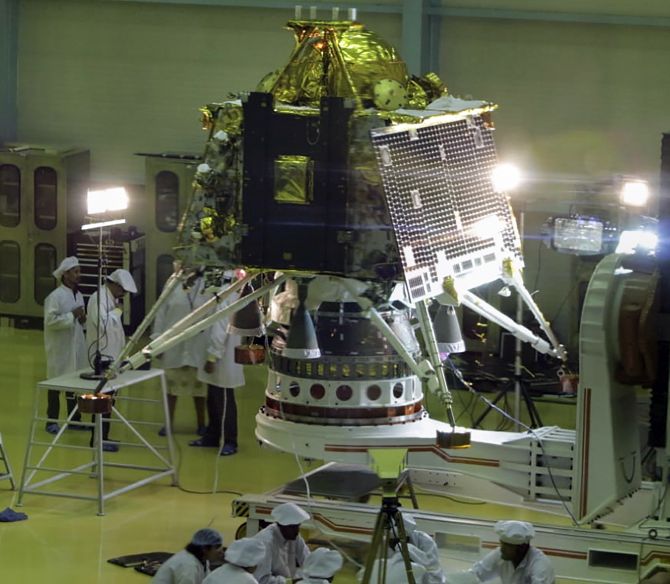 |
| Lander |
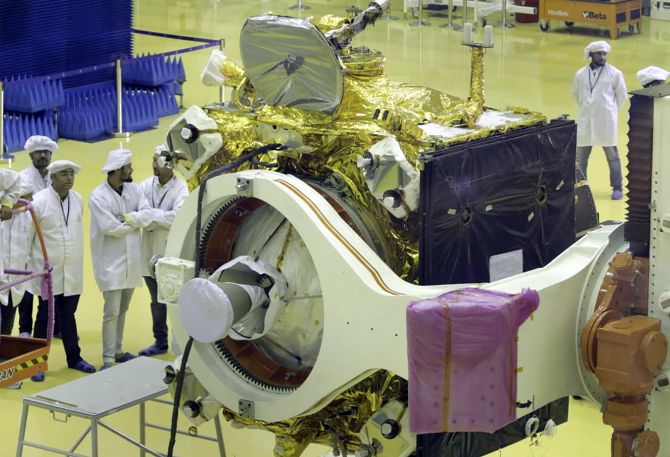 |
| Orbiter |
| Rover |
 |
| Capturing Chandrayaan-2 at the Moon |

 |
| Capturing Chandrayaan-2 in Ecliptic and Equatorial coordinates. |
 |
| Distance of Chandrayaan-2 from Earth |
 |
| Trajectory, comparison of planned launch Jul 14th and realized Jul 22 |
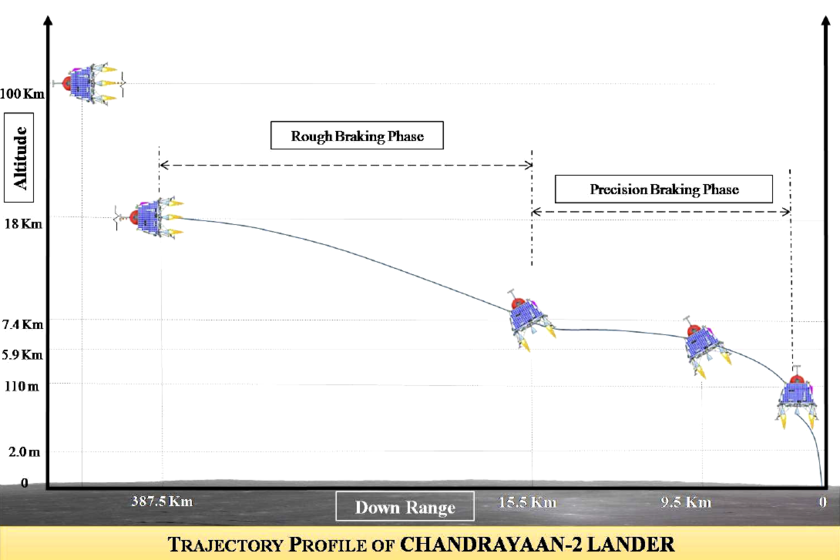 |
CHANDRAYAAN-2 LANDING TRAJECTORY From M. Annadurai et al. presentation to the 10th IAA Symposium on the Future of Space Exploration, Torino, Italy, 27-29 June, 2017. |
 |
Chandrayaan-2 Lunar Lander (with Rover) Soft Landing Sequence (image credit: ISRO) |
The lander's propulsion system consists of eight 50 N (11 lbf) thrusters for attitude control and five 800 N (180 lbf) liquid main engines derived from ISRO's 440 N (99 lbf) Liquid Apogee Motor.[37][47] Initially, the lander design employed four main liquid engines, but a centrally mounted engine was added to handle new requirements of having to orbit the Moon before landing. The additional engine is expected to mitigate upward draft of lunar dust during the soft landing.[48]
Payload
ISRO selected five scientific instruments for the orbiter, four for the lander,[56] and two for the rover.[26][57] While it was initially reported that NASA and ESA would participate in the mission by providing some scientific instruments for the orbiter,[58] ISRO in 2010 had clarified that due to weight restrictions it will not be carrying foreign payloads on this mission.[59]However, in a last moment update just a month before the launch of the mission, a small laser retroreflector from NASA was added to the lander's payload to help scientists measure exact distances to the Moon.[60]Orbiter payload
Large Area Soft X-ray Spectrometer (LASS) from ISRO Satellite Centre (ISAC), Bangalore and Solar X-ray monitor (XSM) from Physical Research Laboratory (PRL), Ahmedabad for mapping major elements present on the lunar surface.[26]
L and S band Synthetic Aperture Radar (SAR) from Space Applications Centre (SAC), Ahmedabad for probing the first few tens of metres of the lunar surface for the presence of different constituents, including water ice. SAR is expected to provide further evidence confirming the presence of water ice below the shadowed regions of the Moon.[26]
Imaging IR Spectrometer (IIRS) from SAC, Ahmedabad for mapping of lunar surface over a wide wavelength range for the study of minerals, water molecules and hydroxyl present.[26]
Neutral Mass Spectrometer (ChACE-2) from Space Physics Laboratory (SPL), Thiruvananthapuram to carry out a detailed study of the lunar exosphere.[26]
Terrain Mapping Camera-2 (TMC-2) from SAC, Ahmedabad for preparing a three-dimensional map essential for studying the lunar mineralogy and geology.[26]Vikram lander payload
Seismometer for studying Moon-quakes near the landing site[56][8][61]
Thermal probe for estimating the thermal properties of the lunar surface[8]
Langmuir probe for measuring the density and variation of lunar surface plasma[56][8]
Radio occultation experiment for measuring the total electron content[8]
A laser retroreflector array (LRA) by NASA Goddard Space Flight Center for precise measurements of the Earth–Moon distance.[60]Pragyan rover payload
Laser induced Breakdown Spectroscope (LIBS) from Laboratory for Electro Optic Systems (LEOS), Bangalore.[26]
Alpha Particle Induced X-ray Spectroscope (APIXS) from PRL, Ahmedabad.
The mission is planned to fly on a Geosynchronous Satellite Launch Vehicle Mark III (GSLV Mk III) with an approximate lift-off mass of 3,877 kg (8,547 lb) from Satish Dhawan Space Centre on Sriharikota Island.[8][7][37] As of June 2019, the mission has an allocated cost of ₹978 crore(approximately US$141 million) which includes ₹603 crore for space segment and ₹375 crore as launch costs on GSLV Mk III.[17][38] Chandrayaan-2 stack would be initially put in a Earth parking orbit of 170 km perigee and 40,400 km apogee by the launch vehicle.[39] It will then perform orbit raising operations followed by trans-lunar injection using its own power.
Orbiter[edit]
The orbiter will orbit the Moon at an altitude of 100 km (62 mi).[40] The mission will carry five instruments on the orbiter. Three of them are new, while two others are improved versions of those flown on Chandrayaan-1. The approximate launch mass will be 2,379 kg (5,245 lb).[2][3][26][41] The Orbiter High Resolution Camera (OHRC) will conduct high-resolution observations of the landing site prior to separation of the lander from the orbiter.[40][1] Interfaces between the orbiter and its GSLV Mk III launch vehicle have been finalised.[42] The orbiter's structure was manufactured by Hindustan Aeronautics Limited and delivered to ISRO Satellite Centre on 22 June 2015.[42][43]
The mission's lander is called Vikram (Sanskrit: विक्रम, lit. 'Valour')[45] named after Vikram Sarabhai (1919-1971) who is widely regarded as the father of the Indian space programme.[46]
The Vikram lander will detach from the orbiter and descend to a lunar orbit of 30 km × 100 km (19 mi × 62 mi) using its 800 N (180 lbf) liquid main engines. It will then perform a comprehensive check of all its on-board systems before attempting to land on the lunar surface. Unlike Chandrayaan-1's Moon Impact Probe, the Vikram lander will make a soft landing, deploy the rover, and perform some scientific activities for approximately 15 days. The approximate combined mass of the lander and rover is 1,471 kg (3,243 lb).[2][3] The preliminary configuration study of the lander was completed in 2013 by the Space Applications Centre (SAC) in Ahmedabad.[27]
The lander's propulsion system consists of eight 50 N (11 lbf) thrusters for attitude control and five 800 N (180 lbf) liquid main engines derived from ISRO's 440 N (99 lbf) Liquid Apogee Motor.[37][47] Initially, the lander design employed four main liquid engines, but a centrally mounted engine was added to handle new requirements of having to orbit the Moon before landing. The additional engine is expected to mitigate upward draft of lunar dust during the soft landing.[48]
Some associated technologies include a high resolution camera, navigation camera, hazard avoidance camera, an 800 N throttleable liquid main engine and attitude thrusters, altimeter, velocity meter, accelerometer, and the software needed to run these components.[1][40] The lander's main engine has successfully undergone a high altitude test for a duration of 513 seconds, and closed loop verification tests of the sensors, actuators and software were completed in 2016.[42] Engineering models of the lander began undergoing ground and aerial tests in late October 2016, in Challakere in the Chitradurgadistrict of Karnataka. ISRO created roughly 10 craters on the surface to help assess the ability of the lander's sensors to select a landing site.[49]
Pragyan rover[edit]
The mission's rover is called Pragyan (Sanskrit: प्रज्ञान, lit. 'Wisdom').[50][51] The rover's mass is about 27 kg (60 lb) and will operate on solar power.[2][3] The rover will move on 6 wheels traversing 500 meter distance on the lunar surface at the rate of 1 cm per second,[52][53] performing on-site chemical analysis and sending the data to the lander, which will relay it to the Earth station.[26][41][17]
Stereoscopic camera-based 3D vision using two NAVCAMs in front of rover will provide the ground team controlling the rovers a 3D view of the surrounding terrain, and help in path-planning by generating a digital elevation model of the terrain.[54]
Control and motor dynamics - The rover has a rocker-bogie suspension system and six wheels, each driven by independent brushless DC electric motors. Steering is accomplished by differential speed of the wheels or Skid Steering.[55]
http://sankara.net/chandrayaan2.html
https://www.isro.gov.in/chandrayaan2-mission#launch-vehicle https://www.isro.gov.in/launchers/gslv-mk-iii
https://directory.eoportal.org/web/eoportal/satellite-missions/c-missions/chandrayaan-2
https://sk.wikipedia.org/wiki/Čandraján-2
https://en.wikipedia.org/wiki/Chandrayaan-2
Large Area Soft X-ray Spectrometer (LASS) from ISRO Satellite Centre (ISAC), Bangalore and Solar X-ray monitor (XSM) from Physical Research Laboratory (PRL), Ahmedabad for mapping major elements present on the lunar surface.[26]
L and S band Synthetic Aperture Radar (SAR) from Space Applications Centre (SAC), Ahmedabad for probing the first few tens of metres of the lunar surface for the presence of different constituents, including water ice. SAR is expected to provide further evidence confirming the presence of water ice below the shadowed regions of the Moon.[26]
Imaging IR Spectrometer (IIRS) from SAC, Ahmedabad for mapping of lunar surface over a wide wavelength range for the study of minerals, water molecules and hydroxyl present.[26]
Neutral Mass Spectrometer (ChACE-2) from Space Physics Laboratory (SPL), Thiruvananthapuram to carry out a detailed study of the lunar exosphere.[26]
Terrain Mapping Camera-2 (TMC-2) from SAC, Ahmedabad for preparing a three-dimensional map essential for studying the lunar mineralogy and geology.[26]Vikram lander payload
Seismometer for studying Moon-quakes near the landing site[56][8][61]
Thermal probe for estimating the thermal properties of the lunar surface[8]
Langmuir probe for measuring the density and variation of lunar surface plasma[56][8]
Radio occultation experiment for measuring the total electron content[8]
A laser retroreflector array (LRA) by NASA Goddard Space Flight Center for precise measurements of the Earth–Moon distance.[60]Pragyan rover payload
Laser induced Breakdown Spectroscope (LIBS) from Laboratory for Electro Optic Systems (LEOS), Bangalore.[26]
Alpha Particle Induced X-ray Spectroscope (APIXS) from PRL, Ahmedabad.
The mission is planned to fly on a Geosynchronous Satellite Launch Vehicle Mark III (GSLV Mk III) with an approximate lift-off mass of 3,877 kg (8,547 lb) from Satish Dhawan Space Centre on Sriharikota Island.[8][7][37] As of June 2019, the mission has an allocated cost of ₹978 crore(approximately US$141 million) which includes ₹603 crore for space segment and ₹375 crore as launch costs on GSLV Mk III.[17][38] Chandrayaan-2 stack would be initially put in a Earth parking orbit of 170 km perigee and 40,400 km apogee by the launch vehicle.[39] It will then perform orbit raising operations followed by trans-lunar injection using its own power.
Orbiter[edit]
The orbiter will orbit the Moon at an altitude of 100 km (62 mi).[40] The mission will carry five instruments on the orbiter. Three of them are new, while two others are improved versions of those flown on Chandrayaan-1. The approximate launch mass will be 2,379 kg (5,245 lb).[2][3][26][41] The Orbiter High Resolution Camera (OHRC) will conduct high-resolution observations of the landing site prior to separation of the lander from the orbiter.[40][1] Interfaces between the orbiter and its GSLV Mk III launch vehicle have been finalised.[42] The orbiter's structure was manufactured by Hindustan Aeronautics Limited and delivered to ISRO Satellite Centre on 22 June 2015.[42][43]
The mission's lander is called Vikram (Sanskrit: विक्रम, lit. 'Valour')[45] named after Vikram Sarabhai (1919-1971) who is widely regarded as the father of the Indian space programme.[46]
The Vikram lander will detach from the orbiter and descend to a lunar orbit of 30 km × 100 km (19 mi × 62 mi) using its 800 N (180 lbf) liquid main engines. It will then perform a comprehensive check of all its on-board systems before attempting to land on the lunar surface. Unlike Chandrayaan-1's Moon Impact Probe, the Vikram lander will make a soft landing, deploy the rover, and perform some scientific activities for approximately 15 days. The approximate combined mass of the lander and rover is 1,471 kg (3,243 lb).[2][3] The preliminary configuration study of the lander was completed in 2013 by the Space Applications Centre (SAC) in Ahmedabad.[27]
The lander's propulsion system consists of eight 50 N (11 lbf) thrusters for attitude control and five 800 N (180 lbf) liquid main engines derived from ISRO's 440 N (99 lbf) Liquid Apogee Motor.[37][47] Initially, the lander design employed four main liquid engines, but a centrally mounted engine was added to handle new requirements of having to orbit the Moon before landing. The additional engine is expected to mitigate upward draft of lunar dust during the soft landing.[48]
Some associated technologies include a high resolution camera, navigation camera, hazard avoidance camera, an 800 N throttleable liquid main engine and attitude thrusters, altimeter, velocity meter, accelerometer, and the software needed to run these components.[1][40] The lander's main engine has successfully undergone a high altitude test for a duration of 513 seconds, and closed loop verification tests of the sensors, actuators and software were completed in 2016.[42] Engineering models of the lander began undergoing ground and aerial tests in late October 2016, in Challakere in the Chitradurgadistrict of Karnataka. ISRO created roughly 10 craters on the surface to help assess the ability of the lander's sensors to select a landing site.[49]
Pragyan rover[edit]
The mission's rover is called Pragyan (Sanskrit: प्रज्ञान, lit. 'Wisdom').[50][51] The rover's mass is about 27 kg (60 lb) and will operate on solar power.[2][3] The rover will move on 6 wheels traversing 500 meter distance on the lunar surface at the rate of 1 cm per second,[52][53] performing on-site chemical analysis and sending the data to the lander, which will relay it to the Earth station.[26][41][17]
Stereoscopic camera-based 3D vision using two NAVCAMs in front of rover will provide the ground team controlling the rovers a 3D view of the surrounding terrain, and help in path-planning by generating a digital elevation model of the terrain.[54]
Control and motor dynamics - The rover has a rocker-bogie suspension system and six wheels, each driven by independent brushless DC electric motors. Steering is accomplished by differential speed of the wheels or Skid Steering.[55]
 |
| Pragyan Rover mounted on the ramp projecting from out of the sides of vikram lander |
 |
| Vikram lander mounted on top of the orbiter of chandrayaan2 |
 |
| Chandrayaan2 Orbiter at launch centre |
http://sankara.net/chandrayaan2.html
https://www.isro.gov.in/chandrayaan2-mission#launch-vehicle https://www.isro.gov.in/launchers/gslv-mk-iii
https://directory.eoportal.org/web/eoportal/satellite-missions/c-missions/chandrayaan-2
https://sk.wikipedia.org/wiki/Čandraján-2
https://en.wikipedia.org/wiki/Chandrayaan-2
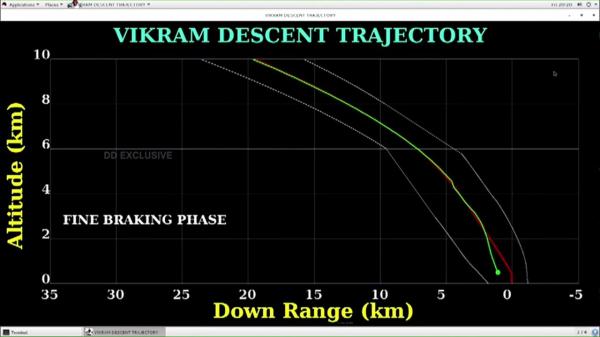
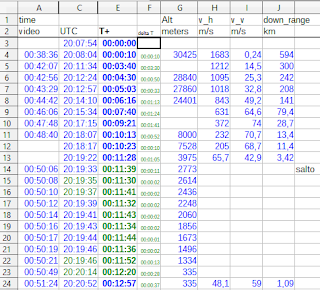




























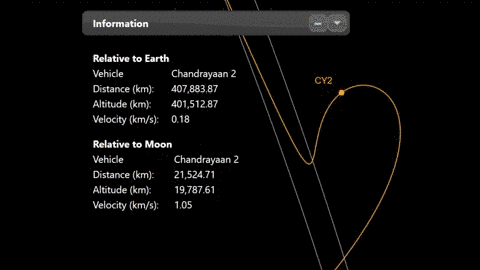





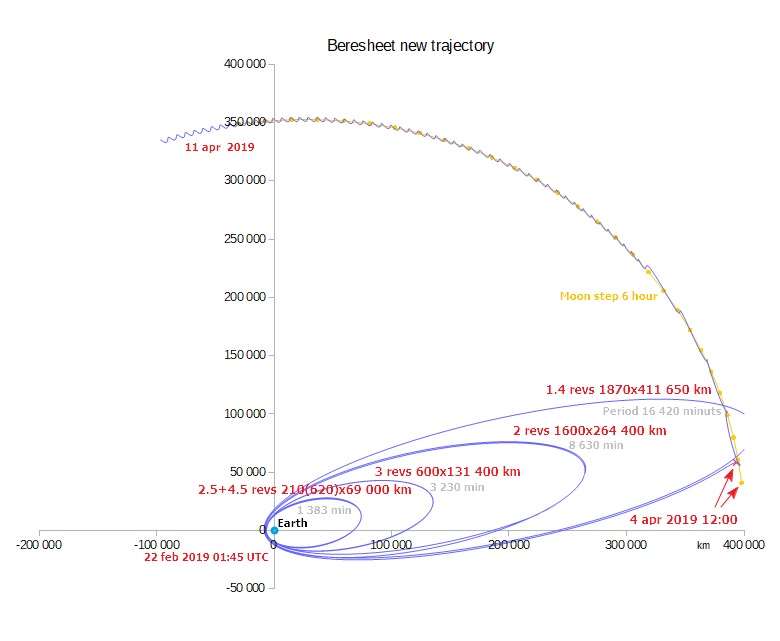

Komentáre
Zverejnenie komentára